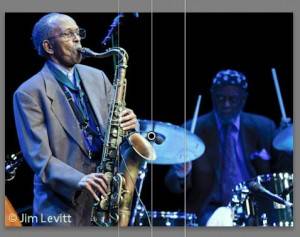I wrote about basic techniques of fixing color casts / setting white balance in Lightroom in my Getting Rid of the Winter Blues post. I thought I would show you some additional tricks for dealing with mixed lighting, using the photo below. It is from a Lightroom workshop student of mine, Jim Levitt (thanks, Jim!). The saxophone player is under red light, and the drummer is under blue light. This is probably what they looked like onstage, so there’s nothing wrong with leaving it as is, but for the sake of example, let’s say you do want to correct the color.
Here is my approach:
1. Set the overall white balance, focusing just on the saxophone player:
I am hoping that the that his suit jacket is really gray, rather than some other color masked by the light shining on him, so that I can use the White Balance Selector tool to at least get me close. I click on they eyedropper in the Basics panel. (See this post for more on why/how this tool works.) The “Pick a target neutral” grid confirms for me that I am selecting the red of his suit. As I hover over the suit, notice how the Navigator panel previews what will happen if I click where my mouse is:
The preview sure is looking better, so I go ahead and click in his suit to apply the change. Lightroom detects whatever color I have clicked on, assumes this color is due to the color cast of the light, and backs that color out of the entire image. The suit itself (or where I clicked anyway) becomes neutral gray:
I lucked out — his suit really was a neutral gray, or pretty close. His skin now looks a little too yellow, so now I slide the Temperature slider a bit away from yellow towards blue. (Note that if there had been no neutral gray or white to work with, the Navigator panel preview would have looked bad everywhere I hovered with the mouse, and I would have had to just use the temperature and tint sliders, focusing on his skin tone.)
2. Work on the drummer
I now have to turn to local tools. The graduated filter and adjustment brush don’t have white balance settings, but I can add color. The secret to eliminating a color cast is to add its opposite color in order to offset it. It may help to see the color wheel to know where to start — opposites are straight across on the wheel.
From this I know that to offset a blue color cast, I need to add yellow.
(Note that with this particular image, I could also get some guidance by using the White Balance Selector tool on the possibly-white parts of the drummer’s bandanna, and then looking at the Temp and Tint sliders to see what colors were added. After getting this guidance, I would undo the white balancing with Ctl/Cmd-Z, and proceed to add color just to the drummer as I do below.)
I start with the graduated filter tool, to affect the whole right side of the image quickly. I reset all its sliders to zero by double-clicking on the word Effect, and drag the filter from right to left, starting towards the center of the image:
At this point there is no change to the image. Now I click on the Color square, and then click and drag in the yellows, watching the drummer’s skin tone as I do it. When I get as close as I can, I let go and then close the color square. (I also increased brightness some.)
This is an improvement, but I added the maximum amount of yellow that I could by choosing a yellow at the top edge of the color box, and the drummer still needs more. I simply do a second graduated filter on top of the first (by clicking on New), with a less saturated yellow (and more brightness to lighten him up a bit more.) The changes from the two are cumulative. Now I have successfully offset the blue color cast, and I am left with my estimation of true underlying colors.
UPDATE: Later versions of Lightroom offer the Temp and Tint sliders in the graduated filter, radial filter and adjustment brush – try those first before using Color.
3. Work on the drum and cymbals.
Using the adjustment brush, I used the same Color technique as I did above with the graduated filter. I ended up painting with yellow to neutralize the lighting on the cymbals, and blue to neutralize the yellow on the drum (mostly introduced by my graduated filter, which applied yellow to the whole right side of the image. (Here is a video on using the adjustment brush in Lightroom, and a post on painting with color.)
Here’s the final result (I could continue to fine-tune the details, but you get the idea!):
In summary, set white balance in the Basics panel to fix a portion of the image, and then use the adjustment brush and/or graduated filter with the opposite color to the color cast to fix the rest.
[sc:signup]










Symbols? I think you mean CYmbAls.
Of course! Thanks for pointing it out … BYT … Blogging While Tired.
BWT, surely… ;)
I do something similar, having created a brush preset with a green tint to remove magenta tones from cold finger, hands, noses, ears, etc, when shooting people in cool or cold conditions. It includes a slight exposure and brightness boost, as well.
Good idea, Mike!
Thanks for the tip, Mike. It is more time consuming method but with good results.
Another possibiity…could you make a second WB correction by clicking on one of the (white?) circles on the drummer’s head bandanna? If you record a snapshot of it, you’d have a record of the color adjustments needed for Temp/Tint. Then you could undo the correction overall and use those numbers/colors to better counteract the blue cast in the background. Maybe too many steps and too technical. But they look like they might be “neutral white” to me.
Your thoughts?
Hi Kathy, how would one translate the temp/tint numbers into HSL or Hex color numbers that the adjustment brush and graduated filter use?
I do see what you mean though that it can give some guidance. I will update the post. ;-)